The Vaginal Inserts Market is estimated to be valued at USD 1.9 billion in 2025 and is projected to reach USD 3.2 billion by 2035, registering a compound annual growth rate (CAGR) of 5.2% over the forecast period.
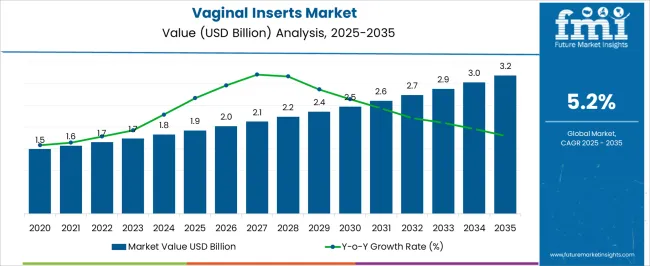
| Metric | Value |
|---|---|
| Vaginal Inserts Market Estimated Value in (2025 E) | USD 1.9 billion |
| Vaginal Inserts Market Forecast Value in (2035 F) | USD 3.2 billion |
| Forecast CAGR (2025 to 2035) | 5.2% |
The Vaginal Inserts market is experiencing steady growth driven by rising awareness of women’s health and increasing adoption of non-oral contraceptive methods. In 2025, the market is characterized by significant demand for user-friendly, effective, and discreet vaginal insert products that address contraception, hormonal therapy, and infection prevention.
Growth in this market is influenced by factors such as increasing healthcare access, expanding awareness campaigns on reproductive health, and the rising preference for localized drug delivery over systemic administration. The market is also benefiting from ongoing product innovation that enhances bioavailability and ensures controlled drug release, leading to improved therapeutic outcomes.
The adoption of vaginal inserts in both emerging and developed regions is being supported by evolving social attitudes, acceptance of self-administered therapies, and the convenience of non-invasive options Future growth opportunities are expected in personalized formulations, multipurpose vaginal inserts, and broader availability through multiple distribution channels, ensuring ease of access and adherence to treatment regimens.
The vaginal inserts market is segmented by product type, applications, distribution channel, and geographic regions. By product type, vaginal inserts market is divided into Vaginal Tablets, Vaginal Capsules, and Vaginal Suppositories. In terms of applications, vaginal inserts market is classified into Vaginal Inserts For Birth Control, Vaginal Inserts For Feminine Hygiene, Vaginal Inserts For Fungal Infections, and Vaginal Inserts For Other Applications. Based on distribution channel, vaginal inserts market is segmented into Vaginal Inserts Sales Through Retail Pharmacy, Vaginal Inserts Sales Through Hospital Pharmacy, Vaginal Inserts Sales Through Online Pharmacy, and Vaginal Inserts Sales Through Fertilization Centers. Regionally, the vaginal inserts industry is classified into North America, Latin America, Western Europe, Eastern Europe, Balkan & Baltic Countries, Russia & Belarus, Central Asia, East Asia, South Asia & Pacific, and the Middle East & Africa.
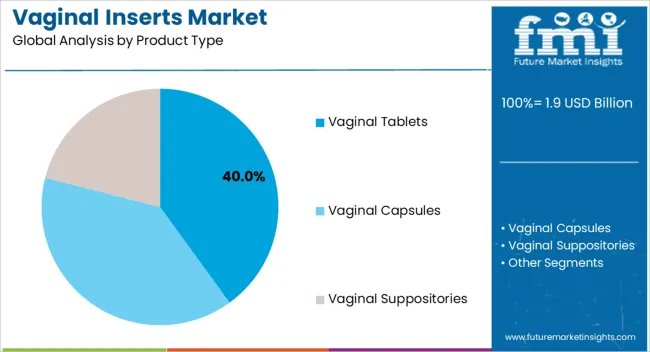
The vaginal tablets segment is projected to hold 40.00% of the Vaginal Inserts market revenue share in 2025, making it the leading product type. This dominance is being attributed to the convenience, stability, and precise dosing offered by tablet formulations. Vaginal tablets allow for controlled drug release and high local bioavailability, which enhances therapeutic effectiveness while minimizing systemic exposure.
Adoption has been further supported by patient preference for easy-to-administer, self-contained dosage forms that can be used discreetly at home. The growth of this segment is reinforced by ongoing innovation in mucoadhesive formulations, which prolong retention time and improve absorption.
Additionally, the cost-effectiveness of production and widespread availability in pharmacies and healthcare facilities has contributed to their leading position With increasing awareness of women’s reproductive health and focus on patient adherence, vaginal tablets are expected to maintain their dominant position in the market, benefiting from both medical recommendations and consumer preference for non-invasive therapeutic solutions.
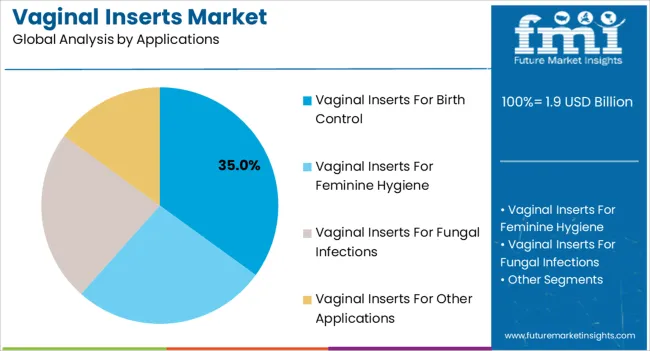
The vaginal inserts for birth control segment is expected to capture 35.00% of the total market revenue in 2025, emerging as the most prominent application segment. Growth is being driven by rising demand for reliable, user-controlled contraceptive options and increasing awareness of family planning methods. These inserts offer targeted hormone delivery, ensuring efficacy while reducing systemic side effects, which enhances user compliance and satisfaction.
Adoption has been reinforced by healthcare campaigns emphasizing accessible and safe contraception, alongside growing acceptance of self-administered solutions. The ability to provide discreet, long-lasting, and reversible contraception has positioned this segment as a preferred method among women of reproductive age.
Additionally, ongoing research in optimizing hormone release profiles and enhancing comfort has contributed to wider adoption With healthcare systems increasingly promoting reproductive health education, vaginal inserts for birth control are anticipated to retain their leading position, supported by convenience, effectiveness, and safety.
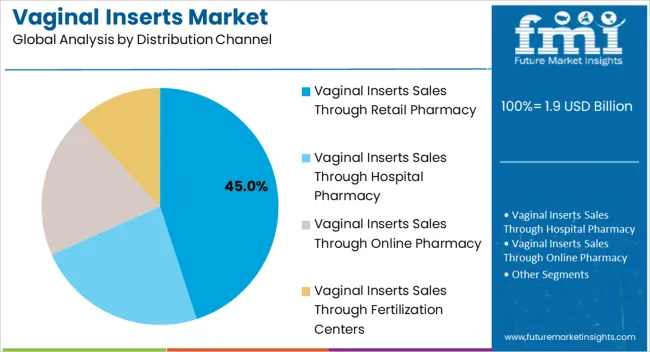
The distribution channel of vaginal inserts through retail pharmacy is projected to hold 45.00% of the market revenue in 2025, establishing it as the leading channel. This dominance is being driven by the accessibility and convenience offered by retail pharmacies, which allow patients to obtain products without requiring specialized medical visits. Growth has been supported by expanding pharmacy networks, increasing availability in urban and semi-urban regions, and rising consumer comfort with self-purchasing over-the-counter healthcare products.
Retail pharmacies also facilitate discreet purchase and immediate availability, enhancing patient adherence and satisfaction. Additionally, promotional efforts, in-store guidance, and trained pharmacy staff contribute to informed decision-making, boosting confidence in product use.
The ability to distribute multiple product types, including tablets and inserts for contraception, through the same channel has reinforced its market leadership As urbanization and pharmacy penetration continue to increase, retail channels are expected to remain the most effective route for reaching the target population, supporting the overall growth of the Vaginal Inserts market.
Vaginal Inserts are solid dosage drug form that is inserted into the vagina with the help of a special applicator. Vaginal inserts have advantages over other dosage forms as it will increase the local concentration of the drug and are also beneficial in refractory cases. Drugs taken in the form of vaginal inserts melt inside the body and absorb directly into the bloodstream.
Vaginal inserts can be used for several indications. Such as birth control, fungal infections, vaginal dryness, hormone supplementation, and vitamin supplementation.
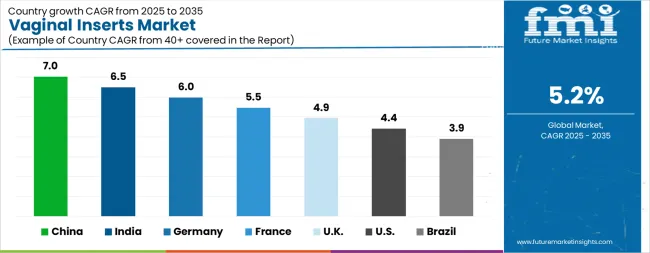
| Country | CAGR |
|---|---|
| China | 7.0% |
| India | 6.5% |
| Germany | 6.0% |
| France | 5.5% |
| UK | 4.9% |
| USA | 4.4% |
| Brazil | 3.9% |
The Vaginal Inserts Market is expected to register a CAGR of 5.2% during the forecast period, exhibiting varied country level momentum. China leads with the highest CAGR of 7.0%, followed by India at 6.5%. Developed markets such as Germany, France, and the UK continue to expand steadily, while the USA is likely to grow at consistent rates. Brazil posts the lowest CAGR at 3.9%, yet still underscores a broadly positive trajectory for the global Vaginal Inserts Market. In 2024, Germany held a dominant revenue in the Western Europe market and is expected to grow with a CAGR of 6.0%. The USA Vaginal Inserts Market is estimated to be valued at USD 670.6 million in 2025 and is anticipated to reach a valuation of USD 1.0 billion by 2035. Sales are projected to rise at a CAGR of 4.4% over the forecast period between 2025 and 2035. While Japan and South Korea markets are estimated to be valued at USD 91.0 million and USD 48.9 million respectively in 2025.

| Item | Value |
|---|---|
| Quantitative Units | USD 1.9 Billion |
| Product Type | Vaginal Tablets, Vaginal Capsules, and Vaginal Suppositories |
| Applications | Vaginal Inserts For Birth Control, Vaginal Inserts For Feminine Hygiene, Vaginal Inserts For Fungal Infections, and Vaginal Inserts For Other Applications |
| Distribution Channel | Vaginal Inserts Sales Through Retail Pharmacy, Vaginal Inserts Sales Through Hospital Pharmacy, Vaginal Inserts Sales Through Online Pharmacy, and Vaginal Inserts Sales Through Fertilization Centers |
| Regions Covered | North America, Europe, Asia-Pacific, Latin America, Middle East & Africa |
| Country Covered | United States, Canada, Germany, France, United Kingdom, China, Japan, India, Brazil, South Africa |
| Key Companies Profiled | AbbVie Inc., Bayer AG, Pfizer Inc., Teva Pharmaceutical Industries Ltd., Allergan plc, Novo Nordisk A/S, Mylan N.V., Endo Pharmaceuticals Inc., TherapeuticsMD, Inc., Amgen Inc., Johnson & Johnson, Merck & Co., Inc., Sanofi S.A., Ferring Pharmaceuticals, and Eli Lilly and Company |
The global vaginal inserts market is estimated to be valued at USD 1.9 billion in 2025.
The market size for the vaginal inserts market is projected to reach USD 3.2 billion by 2035.
The vaginal inserts market is expected to grow at a 5.2% CAGR between 2025 and 2035.
The key product types in vaginal inserts market are vaginal tablets, vaginal capsules and vaginal suppositories.
In terms of applications, vaginal inserts for birth control segment to command 35.0% share in the vaginal inserts market in 2025.






Our Research Products

The "Full Research Suite" delivers actionable market intel, deep dives on markets or technologies, so clients act faster, cut risk, and unlock growth.

The Leaderboard benchmarks and ranks top vendors, classifying them as Established Leaders, Leading Challengers, or Disruptors & Challengers.

Locates where complements amplify value and substitutes erode it, forecasting net impact by horizon

We deliver granular, decision-grade intel: market sizing, 5-year forecasts, pricing, adoption, usage, revenue, and operational KPIs—plus competitor tracking, regulation, and value chains—across 60 countries broadly.

Spot the shifts before they hit your P&L. We track inflection points, adoption curves, pricing moves, and ecosystem plays to show where demand is heading, why it is changing, and what to do next across high-growth markets and disruptive tech

Real-time reads of user behavior. We track shifting priorities, perceptions of today’s and next-gen services, and provider experience, then pace how fast tech moves from trial to adoption, blending buyer, consumer, and channel inputs with social signals (#WhySwitch, #UX).

Partner with our analyst team to build a custom report designed around your business priorities. From analysing market trends to assessing competitors or crafting bespoke datasets, we tailor insights to your needs.
Supplier Intelligence
Discovery & Profiling
Capacity & Footprint
Performance & Risk
Compliance & Governance
Commercial Readiness
Who Supplies Whom
Scorecards & Shortlists
Playbooks & Docs
Category Intelligence
Definition & Scope
Demand & Use Cases
Cost Drivers
Market Structure
Supply Chain Map
Trade & Policy
Operating Norms
Deliverables
Buyer Intelligence
Account Basics
Spend & Scope
Procurement Model
Vendor Requirements
Terms & Policies
Entry Strategy
Pain Points & Triggers
Outputs
Pricing Analysis
Benchmarks
Trends
Should-Cost
Indexation
Landed Cost
Commercial Terms
Deliverables
Brand Analysis
Positioning & Value Prop
Share & Presence
Customer Evidence
Go-to-Market
Digital & Reputation
Compliance & Trust
KPIs & Gaps
Outputs
Full Research Suite comprises of:
Market outlook & trends analysis
Interviews & case studies
Strategic recommendations
Vendor profiles & capabilities analysis
5-year forecasts
8 regions and 60+ country-level data splits
Market segment data splits
12 months of continuous data updates
DELIVERED AS:
PDF EXCEL ONLINE
Vaginal Spetula Market Size and Share Forecast Outlook 2025 to 2035
Vaginal Antifungals Market Size and Share Forecast Outlook 2025 to 2035
Vaginal Specula Market Trends and Forecast 2025 to 2035
Vaginal and Vulval Inflammatory Diseases Treatment Market - Demand & Innovations 2025 to 2035
Vaginal Applicator Market Growth & Health Innovations 2024-2034
Vaginal Exam Specula Market
Vulvovaginal Candidiasis Treatment Market Size and Share Forecast Outlook 2025 to 2035
At-Home Vaginal pH Test Kit Market Size and Share Forecast Outlook 2025 to 2035
Custom Inserts Market
Scarfing Inserts Market Analysis - Size, Share, and Forecast Outlook 2025 to 2035
Packaging Inserts Market Insights - Growth & Forecast 2025 to 2035
Valve Seat Inserts Market Size and Share Forecast Outlook 2025 to 2035
Run Flat Tire Inserts Market Growth - Trends & Forecast 2025 to 2035
Foam Packaging Inserts Market Analysis, Size, Share & Forecast 2025 to 2035
Indexable Tool Inserts Market
Aircraft Galley Inserts Market
Japan Valve Seat Inserts Market Trend Analysis Based on Sales Channel, Material, Engine, End-Use and Provinces 2025 to 2035
Aerospace Electrical Inserts Market Size and Share Forecast Outlook 2025 to 2035
Stainless Steel Turning Inserts Market Size and Share Forecast Outlook 2025 to 2035

Thank you!
You will receive an email from our Business Development Manager. Please be sure to check your SPAM/JUNK folder too.
Chat With
MaRIA